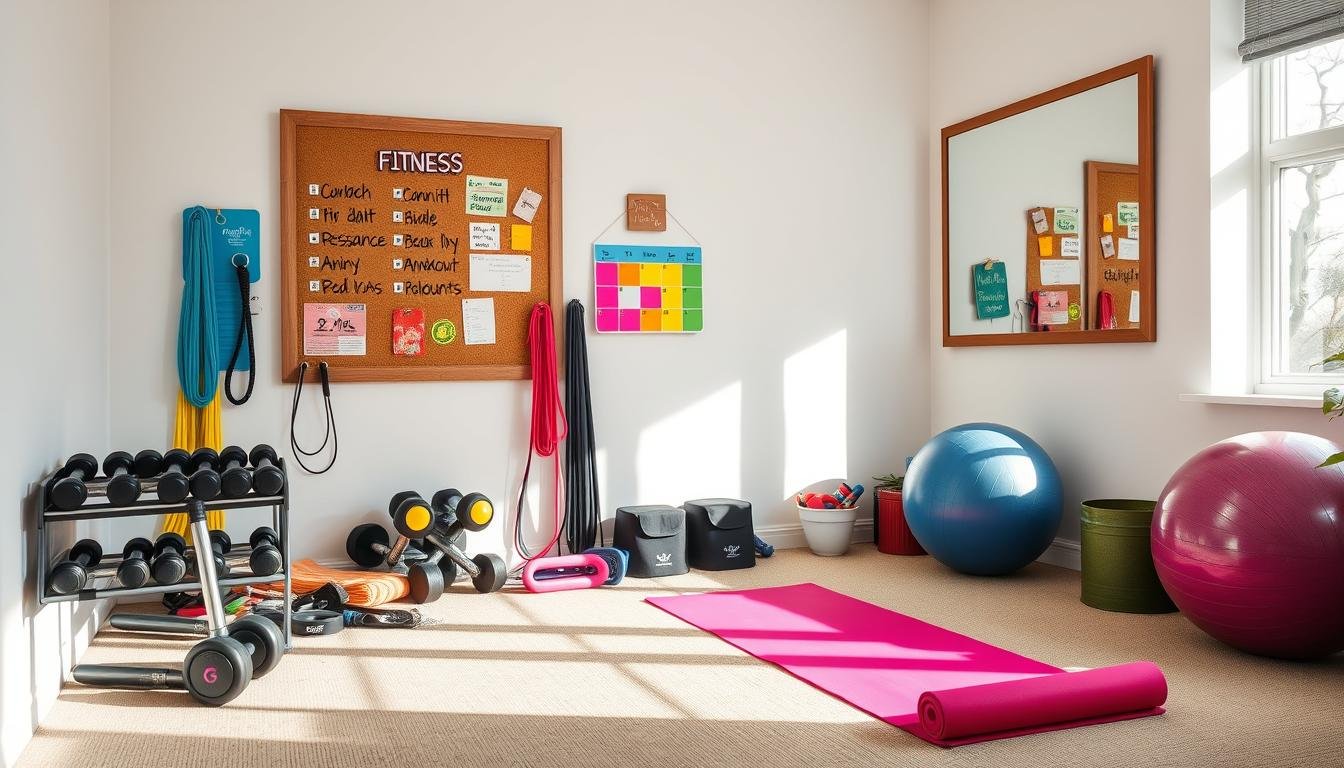Embarking on the creation of a workout plan is an indispensable step for novices aspiring to reach their fitness objectives. Whether the goal is to elevate cardiovascular health, augment muscular strength, or boost overall wellness, a meticulously crafted plan is paramount. This guide will offer a detailed, step-by-step methodology for constructing a well-rounded, enduring exercise regimen, tailored to your unique requirements.
The foundational step necessitates an assessment of your current fitness status, the establishment of SMART (Specific, Measurable, Achievable, Relevant, and Time-bound) objectives, and the identification of any physical constraints or health concerns. Subsequently, you will be introduced to the fundamental elements of a beginner’s workout regimen, encompassing the optimal training frequency, the critical balance between strength training and cardio, and the indispensable role of rest and recovery days.
Progressing further, the guide will dissect essential exercises and correct technique, underscoring the significance of progressive overload and monitoring your advancement over time. Ultimately, we will examine the importance of nutrition and hydration in bolstering your fitness endeavors, ensuring a holistic approach to attaining your objectives.
Understanding Fitness Goals and Initial Assessment
Initiating a workout regimen necessitates an evaluation of one’s current physical condition. This evaluation can be achieved through the measurement of pulse rate, walking or running duration, pushup capacity, and body metrics. Recognizing one’s baseline fitness is paramount for the establishment of SMART (Specific, Measurable, Attainable, Relevant, Timely) fitness objectives.
Measuring Current Fitness Level
Resting heart rates serve as indicators of cardiovascular health, with lower rates typically signifying superior fitness. The formulation of specific and quantifiable objectives is imperative; for example, a novice might aspire to accomplish a 30-minute regimen of bodyweight exercises, executed thrice weekly.
Setting SMART Fitness Goals
Experts in personal training advocate for the SMART approach to goal-setting, emphasizing specificity, measurability, attainability, relevance, and timeliness. The incorporation of emotional elements (the “E” in SMART) into goals enhances motivation and renders them more concrete. It is vital to strike a balance in workout planning, allowing for adequate recovery periods to facilitate muscle repair and expansion.
Identifying Physical Limitations and Health Considerations
When crafting a workout regimen, it is imperative to take into account any physical constraints or health issues. Seeking counsel from a healthcare professional can unveil potential concerns and ensure that the workout plan is tailored to meet individual requirements. Flexibility in goal-setting is crucial, allowing for adjustments as fitness levels evolve, ensuring sustained progress, motivation, and safety.
Essential Components of a Beginner's Guide to Creating a Workout Plan
Developing an effective workout plan for beginners necessitates a meticulous selection of workout components. It is imperative to integrate cardiovascular exercises, strength training, and flexibility routines to engage all major muscle groups and enhance overall fitness. The exercise selection should prioritize compound movements that engage multiple muscle groups, alongside isolation exercises to target specific areas.
The frequency of training should be tailored to your schedule and fitness objectives. Aim for 2-3 strength training sessions weekly, with a minimum of one day of rest in between. Incorporate cardio activities, such as brisk walking, jogging, or cycling, on non-strength training days or as a warm-up/cooldown. It is crucial to include dynamic warm-ups and static stretches to improve flexibility and prevent injuries.
To introduce variety and challenge to your regimen, consider a blend of bodyweight exercises, free weights, and resistance machines. This strategy engages diverse muscle groups and sustains motivation throughout your fitness journey. Consistent monitoring of your workout components, exercise selection, and training frequency is vital for tracking progress and making necessary adjustments to your plan over time.
| Workout Components | Recommendations |
|---|---|
| Cardiovascular Exercises | Brisk walking, jogging, cycling, swimming |
| Strength Training | Compound exercises, isolation exercises, bodyweight, free weights, resistance machines |
| Flexibility | Dynamic warm-ups, static stretches, mobility drills |
| Training Frequency | 2-3 strength training sessions per week, with at least one day of rest in between |
Building Your Weekly Workout Schedule
Creating an effective workout schedule is paramount for novices embarking on their fitness odyssey. Achieving equilibrium between the intensity of workouts, the frequency of training, and the necessity of rest and recovery is crucial. Adherence to a meticulously planned weekly regimen enables gradual advancement towards fitness objectives, mitigating the risks of burnout and injury.
Recommended Training Frequency for Beginners
Beginners should aspire to engage in 3-4 workout sessions weekly, interspersed with rest days. This cadence is optimal for initiating muscle hypertrophy and cardiovascular enhancement, preventing excessive strain on the body. As familiarity with regular physical activity grows, increment the duration and intensity of your exercises.
Balancing Strength Training and Cardio
Attaining a holistic fitness regimen necessitates the integration of strength training and cardio exercises. Alternating focus days, allocating one session to strength training and the subsequent to cardio, is a viable strategy. Another approach involves amalgamating both in a comprehensive full-body workout, incorporating strength exercises such as squats, lunges, and push-ups alongside high-intensity cardio bursts.
Importance of Rest and Recovery Days
Rest and recovery periods are as vital as the workouts themselves. Incorporate at least one full rest day weekly to facilitate muscle repair and regeneration. This reprieve is indispensable for averting overtraining and ensuring the body’s capacity to adapt to exercise-induced stress. Consider segmenting your workouts into upper body, lower body, and full-body sessions to comprehensively engage all muscle groups throughout the week.
Adopting a structured weekly workout schedule that harmonizes workout frequency, strength training, cardio, and rest periods lays the groundwork for enduring progress and long-term fitness triumph.
Fundamental Exercises and Proper Form
Initiating your fitness odyssey necessitates a thorough understanding of fundamental exercises and adherence to proper form. The adoption of correct exercise technique is paramount, as it not only enhances the efficacy of your workouts but also mitigates the risk of injury. It is advisable to commence with bodyweight exercises, progressing to those with weights once your form is impeccable.
Integrate a diverse array of compound exercises that engage major muscle groups, such as the legs, chest, back, shoulders, and core. Squats, lunges, push-ups, rows, and planks are exemplary for establishing a robust foundation. The essence of success lies not in the weight lifted but in the quality and control of your movements.
Seeking guidance from instructional videos or a fitness professional is crucial to ensure the accuracy of your exercise execution. Such support can offer invaluable feedback, enabling you to refine your technique. Research indicates that 70% of beginners who work with a personal trainer to learn proper exercise form are less likely to get injured during their workouts.
| Exercise | Proper Form | Benefits |
|---|---|---|
| Squats | Feet shoulder-width apart, chest up, core engaged, hips back, knees tracking over toes. | Builds lower body strength, improves mobility, and engages the core. |
| Push-ups | Hands shoulder-width apart, body in a straight line, core engaged, lower chest to the floor. | Strengthens the chest, shoulders, and triceps while improving upper body pushing power. |
| Rows | Hinge at the hips, keep your back flat, pull the weight towards your chest, elbows close to your body. | Strengthens the back, biceps, and shoulders, improving overall upper body pulling strength. |
By mastering the basic exercises and maintaining proper form, you’ll establish a solid foundation for a safe and effective exercise technique that will endure throughout your fitness journey.
Progressive Overload and Tracking Progress
Attainment of enduring fitness objectives necessitates a methodical strategy, encompassing progressive overload and diligent monitoring of workout advancements. Progressive overload entails the incremental augmentation of physical exertion, facilitating muscle adaptation and fortification. This process is pivotal for enhancing bodily strength and resilience.
Incremental weight elevation or repetition augmentation in exercises serves as a cornerstone for progressive overload. Such incremental challenges foster progressive strength and endurance enhancement, mitigating injury risks. It is imperative to document workouts, whether through manual journaling or digital fitness tracking apps, to track progress and refine workout progression strategies as necessary.
Periodic reassessment of fitness tracking and progressive overload objectives is vital for sustaining motivation and realizing fitness aspirations. Establish both immediate and distant goals, and acknowledge milestones achieved. Utilizing fitness monitoring devices to track metrics such as heart rate, caloric expenditure, and other pertinent data can provide profound insights into your body’s response to your training regimen.
Incorporating progressive overload and consistent tracking into your regimen will propel you towards realizing your fitness aspirations. Embrace patience and persistence, as a strategic and data-driven methodology will yield significant outcomes over time.
Nutrition and Hydration for Workout Success
Optimizing your workout regimen through a balanced diet is paramount for realizing your fitness aspirations. It is imperative to incorporate a diet rich in protein, complex carbohydrates, and healthy fats. These nutrients are pivotal in sustaining energy levels, facilitating muscle growth, and enhancing recovery processes. Hydration plays a crucial role, as muscle tissue is predominantly composed of water, necessitating a minimum daily intake of one gallon (128 ounces) of water, both pre- and post-exercise, to ensure optimal hydration.
Incorporating pre- and post-workout snacks is advisable to bolster energy reserves and muscle repair mechanisms. A pre-workout protein shake can elevate resting energy expenditure by up to 6.5% for up to 48 hours, enhancing your training session’s efficacy. Post-exercise, it is recommended to consume at least 20 grams of whey protein or a blend of 40 grams of mixed protein (whey and casein) to stimulate muscle recovery and growth.
For athletes seeking to elevate their performance, certain supplements can be beneficial. Creatine supplementation, at a dosage of 2-5 grams daily, can augment muscle stores, enabling more intense training and heavier lifts. The optimal dose of beta-alanine for performance enhancement is 4-5 grams, best distributed throughout the day. Post-workout, a 10-gram intake of BCAAs is highly beneficial, even in caloric deficit scenarios.





